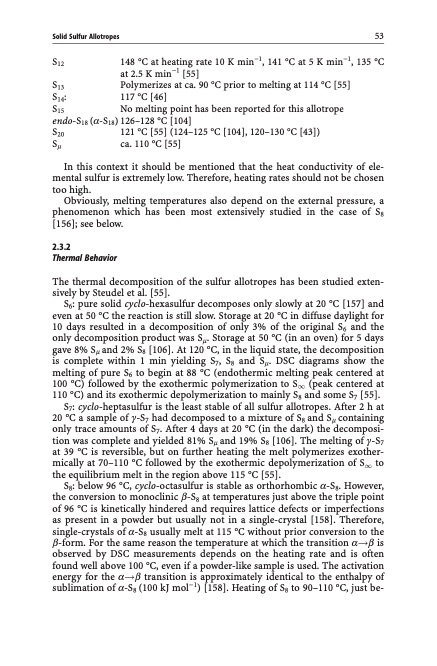
PDF Publication Title:
Text from PDF Page: 063
Solid Sulfur Allotropes 53 S12 S13 S14: S15 endo-S18 (a-S18) S20 Sm 148 C at heating rate 10 K min1, 141 C at 5 K min1, 135 C at 2.5 K min1 [55] Polymerizes at ca. 90 C prior to melting at 114 C [55] 117 C [46] No melting point has been reported for this allotrope 126–128 C [104] 121 C [55] (124–125 C [104], 120–130 C [43]) ca. 110 C [55] In this context it should be mentioned that the heat conductivity of ele- mental sulfur is extremely low. Therefore, heating rates should not be chosen too high. Obviously, melting temperatures also depend on the external pressure, a phenomenon which has been most extensively studied in the case of S8 [156]; see below. 2.3.2 Thermal Behavior The thermal decomposition of the sulfur allotropes has been studied exten- sively by Steudel et al. [55]. S6: pure solid cyclo-hexasulfur decomposes only slowly at 20 C [157] and even at 50 C the reaction is still slow. Storage at 20 C in diffuse daylight for 10 days resulted in a decomposition of only 3% of the original S6 and the only decomposition product was Sm. Storage at 50 C (in an oven) for 5 days gave 8% Sm and 2% S8 [106]. At 120 C, in the liquid state, the decomposition is complete within 1 min yielding S7, S8 and Sm. DSC diagrams show the melting of pure S6 to begin at 88 C (endothermic melting peak centered at 100 C) followed by the exothermic polymerization to S1 (peak centered at 110 C) and its exothermic depolymerization to mainly S8 and some S7 [55]. S7: cyclo-heptasulfur is the least stable of all sulfur allotropes. After 2 h at 20 C a sample of g-S7 had decomposed to a mixture of S8 and Sm containing only trace amounts of S7. After 4 days at 20 C (in the dark) the decomposi- tion was complete and yielded 81% Sm and 19% S8 [106]. The melting of g-S7 at 39 C is reversible, but on further heating the melt polymerizes exother- mically at 70–110 C followed by the exothermic depolymerization of S1 to the equilibrium melt in the region above 115 C [55]. S8: below 96 C, cyclo-octasulfur is stable as orthorhombic a-S8. However, the conversion to monoclinic b-S8 at temperatures just above the triple point of 96 C is kinetically hindered and requires lattice defects or imperfections as present in a powder but usually not in a single-crystal [158]. Therefore, single-crystals of a-S8 usually melt at 115 C without prior conversion to the b-form. For the same reason the temperature at which the transition a!b is observed by DSC measurements depends on the heating rate and is often found well above 100 C, even if a powder-like sample is used. The activation energy for the a!b transition is approximately identical to the enthalpy of sublimation of a-S8 (100 kJ mol1) [158]. Heating of S8 to 90–110 C, just be-PDF Image | Topics in Current Chemistry

PDF Search Title:
Topics in Current ChemistryOriginal File Name Searched:
Elemental-Sulfur-und-Sulfur-Rich-Compounds-I.pdfDIY PDF Search: Google It | Yahoo | Bing
Sulfur Deposition on Carbon Nanofibers using Supercritical CO2 Sulfur Deposition on Carbon Nanofibers using Supercritical CO2. Gamma sulfur also known as mother of pearl sulfur and nacreous sulfur... More Info
CO2 Organic Rankine Cycle Experimenter Platform The supercritical CO2 phase change system is both a heat pump and organic rankine cycle which can be used for those purposes and as a supercritical extractor for advanced subcritical and supercritical extraction technology. Uses include producing nanoparticles, precious metal CO2 extraction, lithium battery recycling, and other applications... More Info
| CONTACT TEL: 608-238-6001 Email: greg@infinityturbine.com | RSS | AMP |